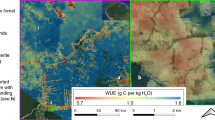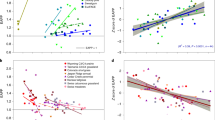Abstract
Water availability limits plant growth and production in almost all terrestrial ecosystems1,2,3,4,5. However, biomes differ substantially in sensitivity of aboveground net primary production (ANPP) to between-year variation in precipitation6,7,8. Average rain-use efficiency (RUE; ANPP/precipitation) also varies between biomes, supposedly because of differences in vegetation structure and/or biogeochemical constraints8. Here we show that RUE decreases across biomes as mean annual precipitation increases. However, during the driest years at each site, there is convergence to a common maximum RUE (RUEmax) that is typical of arid ecosystems. RUEmax was also identified by experimentally altering the degree of limitation by water and other resources. Thus, in years when water is most limiting, deserts, grasslands and forests all exhibit the same rate of biomass production per unit rainfall, despite differences in physiognomy and site-level RUE. Global climate models9,10 predict increased between-year variability in precipitation, more frequent extreme drought events, and changes in temperature. Forecasts of future ecosystem behaviour should take into account this convergent feature of terrestrial biomes.
This is a preview of subscription content, access via your institution
Access options
Subscribe to this journal
Receive 51 print issues and online access
$199.00 per year
only $3.90 per issue
Buy this article
- Purchase on Springer Link
- Instant access to full article PDF
Prices may be subject to local taxes which are calculated during checkout


Similar content being viewed by others
References
Rosenzweig, M. L. Net primary productivity of terrestrial communities: prediction from climatological data. Am. Nat. 102, 67–74 (1968)
Lieth, H. in Primary Productivity of the Biosphere (eds Lieth, H. & Whittaker, R. H.) 237–263 (Springer, New York, 1975)
Webb, W. L., Lauenroth, W. K., Szarek, S. R. & Kinerson, R. S. Primary production and abiotic controls in forests, grasslands, and desert ecosystems of the United States. Ecology 64, 134–151 (1986)
Sala, O. E., Parton, W. J., Joyce, L. A. & Lauenroth, W. K. Primary production of the central grassland region of the United States. Ecology 69, 40–45 (1988)
Walter, H. Grassland, Savanne und Busch der arideren Teile Afrikas in ihrer okologischen Bedingtheit. Jb. Wiss. Bot. 87, 750–760 (1939)
Paruelo, J. M., Lauenroth, W. K., Burke, I. C. & Sala, O. E. Grassland precipitation–use efficiency varies across a resource gradient. Ecosystems 2, 64–68 (1999)
Knapp, A. K. & Smith, M. D. Variation among biomass in temporal dynamics of aboveground primary production. Science 291, 481–484 (2001)
Veron, S. V., Paruelo, J. M., Sala, O. E. & Lauenroth, W. K. Environmental controls of primary production in agricultural systems of the Argentine Pampas. Ecosystems 5, 625–635 (2002)
IPCC . Climate Change 2001: Synthesis Report. A Contribution of Working Groups I, II, and III to the Third Assessment Report of the Intergovernmental Panel on Climate Change (eds Watson, R. T. and Core Writing Team) (Cambridge Univ. Press, Cambridge, 2001)
Easterling, D. R. et al. Climate extremes: Observations, modeling, and impacts. Science 289, 2068–2074 (2000)
Schimel, D. S. et al. Recent patterns and mechanisms of carbon exchange by terrestrial ecosystems. Nature 414, 169–172 (2001)
Noy-Meir, I. Desert ecosystems: environment and producers. Annu. Rev. Ecol. Syst. 4, 51–58 (1973)
Smith, S. D. et al. Elevated CO2 increases productivity and invasive species success in an arid ecosystem. Nature 408, 79–82 (2000)
Shaw, M. R. et al. Grassland responses to global environmental changes suppressed by elevated CO2 . Science 298, 1987–1990 (2002)
Lauenroth, W. K. & Sala, O. E. Long-term forage production of North American shortgrass steppe. Ecol. Appl. 2, 397–403 (1992)
Grime, J. P. Evidence for existence of 3 primary strategies in plants and its relevance to ecological and evolutionary theory. Am. Nat. 111, 1169–1194 (1977)
Ehleringer, J. R. in Terrestrial Global Productivity (eds Roy, J., Saugier, B. & Mooney, H. A.) 345–362 (Academic, San Diego, 2001)
Seastedt, T. R. & Knapp, A. K. Consequences of nonequilibrium resource availability across multiple time scales: the transient maxima hypothesis. Am. Nat. 141, 421–433 (1993)
Austin, A. T. & Vitousek, P. M. Nutrient dynamics on a precipitation gradient in Hawai'i. Oecologia 113, 519–529 (1998)
Chapin, F. S. III, Matson, P. A. & Mooney, H. A. Principles of Terrestrial Ecosystem Ecology (Springer, New York, 2002)
Knapp, A. K. et al. Rainfall variability, carbon cycling, and plant species diversity in a mesic grassland. Science 298, 2202–2205 (2003)
Schlesinger, W. H. Biogeochemistry: An Analysis of Global Change (Academic, San Diego, 1997)
Smith, S. D., Monson, R. K. & Anderson, J. E. Physiological Ecology of North American Desert Plants (Springer, New York, 1997)
Aber, J. et al. Nitrogen saturation in temperate forest ecosystems. Bioscience 48, 921–934 (1998)
Ehleringer, J. R. & Mooney, H. A. in Encyclopedia of Plant Physiology (New Series) vol 12C (eds Lange, O. L., Nobel, P. S., Osmond, C. B. & Ziegler, H.) 205–231 (Springer, New York, 1983)
Schlesinger, W. H. et al. Biological feedbacks in global desertification. Science 247, 1043–1048 (1990)
Reynolds, J. F., Virginia, R. A., Kemp, P. R., de Soyza, A. G. & Tremmel, D. C. Impact of drought on desert shrubs: effects of seasonality and degree of resource island development. Ecol. Monogr. 69, 69–106 (1999)
Le Houerou, H. N., Bingham, R. L. & Skerbek, W. Relationship between the variability of primary production and the variability of annual precipitation in world arid lands. J. Arid Environ. 15, 1–18 (1998)
Turner, F. B. & Randall, D. C. Net production by shrubs and winter annuals in southern Nevada. J. Arid Environ. 17, 23–36 (1989)
Jobbagy, E. G. & Sala, O. E. Controls of grass and shrub aboveground production in the Patagonian steppe. Ecol. Appl. 10, 541–549 (2000)
Acknowledgements
We thank J. Bronstein, J. Cable, G. Davidowitz, A. Eilts, B. Enquist, D. Ignace, A. Kerkhoff, D. Potts, D. Schimel, L. Venable and M. Pavao-Zuckerman for comments on the manuscript. This work derived from an NCEAS working group, PrecipNet (principal investigator M.E.L.), supported by the National Science Foundation, the University of California, and the Santa Barbara campus. We acknowledge the support of the United States Department of Energy, the National Park Service, the National Science Foundation, and the United States Department of Agriculture.
Author information
Authors and Affiliations
Corresponding authors
Ethics declarations
Competing interests
The authors declare that they have no competing financial interests.
Supplementary information
Supplementary Tables
Table 1) Site information, mean annual precipitation, mean annual net primary production for the 14 study sites; Table 2) Stepwise multiple linear regression analysis of aboveground net primary production using annual precipitation, measures of intra-annual precipitation variability, maximum growing season temperature, and previous yr ANPP, for the 14 study sites categorized by their long-term mean ANPP. (DOC 78 kb)
Rights and permissions
About this article
Cite this article
Huxman, T., Smith, M., Fay, P. et al. Convergence across biomes to a common rain-use efficiency. Nature 429, 651–654 (2004). https://doi.org/10.1038/nature02561
Received:
Accepted:
Issue Date:
DOI: https://doi.org/10.1038/nature02561
This article is cited by
-
Analysis of ecological drought risk characteristics and leading factors in the Yellow River Basin
Theoretical and Applied Climatology (2024)
-
Bedrock mediates responses of ecosystem productivity to climate variability
Communications Earth & Environment (2023)
-
Assessment of multidimensional drought vulnerability using exposure, sensitivity, and adaptive capacity components
Environmental Monitoring and Assessment (2023)
-
Traits that distinguish dominant species across aridity gradients differ from those that respond to soil moisture
Oecologia (2023)
-
Dry-season irrigation further promotes the growth of Eucalyptus urophylla × E. grandis plantations under the conventional fertilization
New Forests (2023)
Comments
By submitting a comment you agree to abide by our Terms and Community Guidelines. If you find something abusive or that does not comply with our terms or guidelines please flag it as inappropriate.



